Samsung Q80C Reviewed at $1,099.00 (55")
Product Name: Samsung Q80C
Product Description: 2023 4K QLED TV
-
Design - 9.1/10
9.1/10
-
Video Quality - 8.5/10
8.5/10
-
Ports & Connectivity - 9.4/10
9.4/10
-
OS, Apps and Features - 9.5/10
9.5/10
-
Price / Quality - 8.7/10
8.7/10
Summary
Reviewed at $1,099.00 (55″)
Pros
- Good color coverage
- Satisfying brightness
- Strong gaming features
- Good price
Cons
- Mediocre out-of-the-box performance
- Visible blooming
- Grey-ish blacks
- No Dolby Vision or DTS
Cheapest Places to Buy :
*We are a reader-supported website. When you buy through links on our site, we may earn a small affiliate commission at no extra cost to you. Home Media Entertainment does not accept money for reviews.*
It was about time we take a look at Samsung‘s QLED series in 2023. And what better way to start than to look at the best model in the series. As such in our Samsung Q80C review today we will be testing this new QLED TV that comes with a lot of interesting features and obviously a very affordable price.
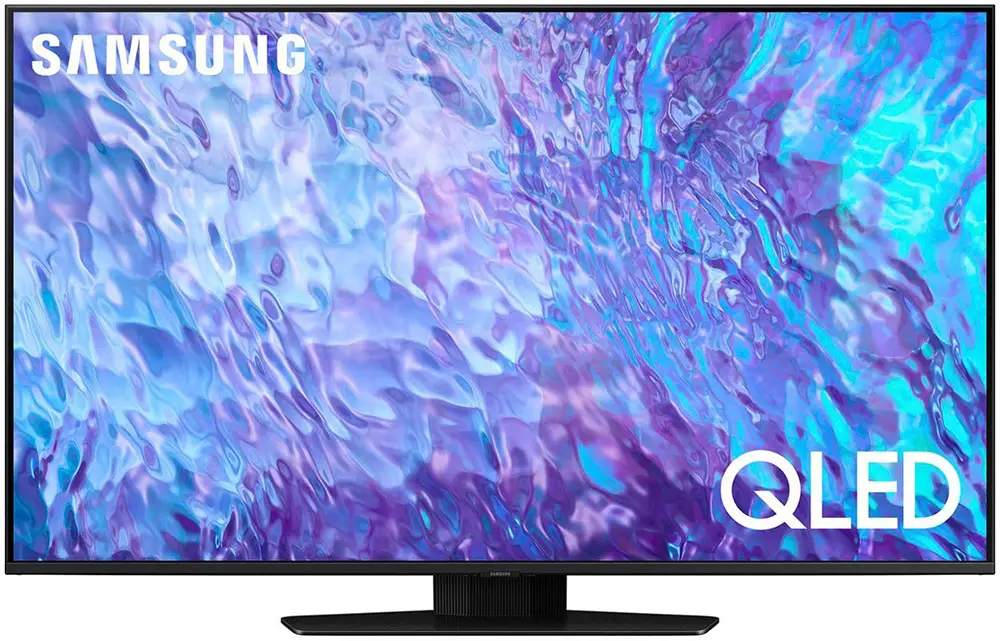
The Q80C is the direct replacement of last year’s Samsung Q80B. Looking at the specs not many things seems to have changed and the new model keeps a lot of the same features we saw last year. But digging deeper you will see that the two TVs do have some differences and we will make sure to point them out in our tests.
But as always let’s take a look at the specs real quick. The Q80C is using a 100/120Hz ADS panel. It is using a Full Array backlight with local dimming (FALD) and processing duties are handled by the Neural Quantum Processor 4K. It supports HDR10+, uses the Object Tracking Sound Lite audio system and utilizes the latest Tizen 2023. Furthermore it has four HDMI 2.1 ports with support for VRR, ALLM, HFR and eARC.
As we mentioned above the Q80C looks awfully similar to the Q80B with a minor upgrade on the processor and a small downgrade to the audio system. Are these the only differences between the two? Keep reading as we put it to the test to find out.
Design
As always we start with the design. Looking the Q80C from all sides its evident that what we have here is a different design compared to the one used in the Q80B. It is not fundamentally different but the Q80C is definitely not using the same shell its predecessor had.
The TV is nice looking overall. It’s slim enough, for a FALD TV, with thin bezels and tiny borders. As a result the image is more pronounced which surely adds to the immersion you get.
Measurements
Obviously with a TV that uses a FALD backlight you should not expect OLED kind of thickness. Nevertheless the Q80C managed to measure thinner than its 2022 replacement as we measured it 1.8″ (4.6cm) at its thickest point.
Its black borders were also more thin this year, not by much, but there is a notable difference which is for the better.
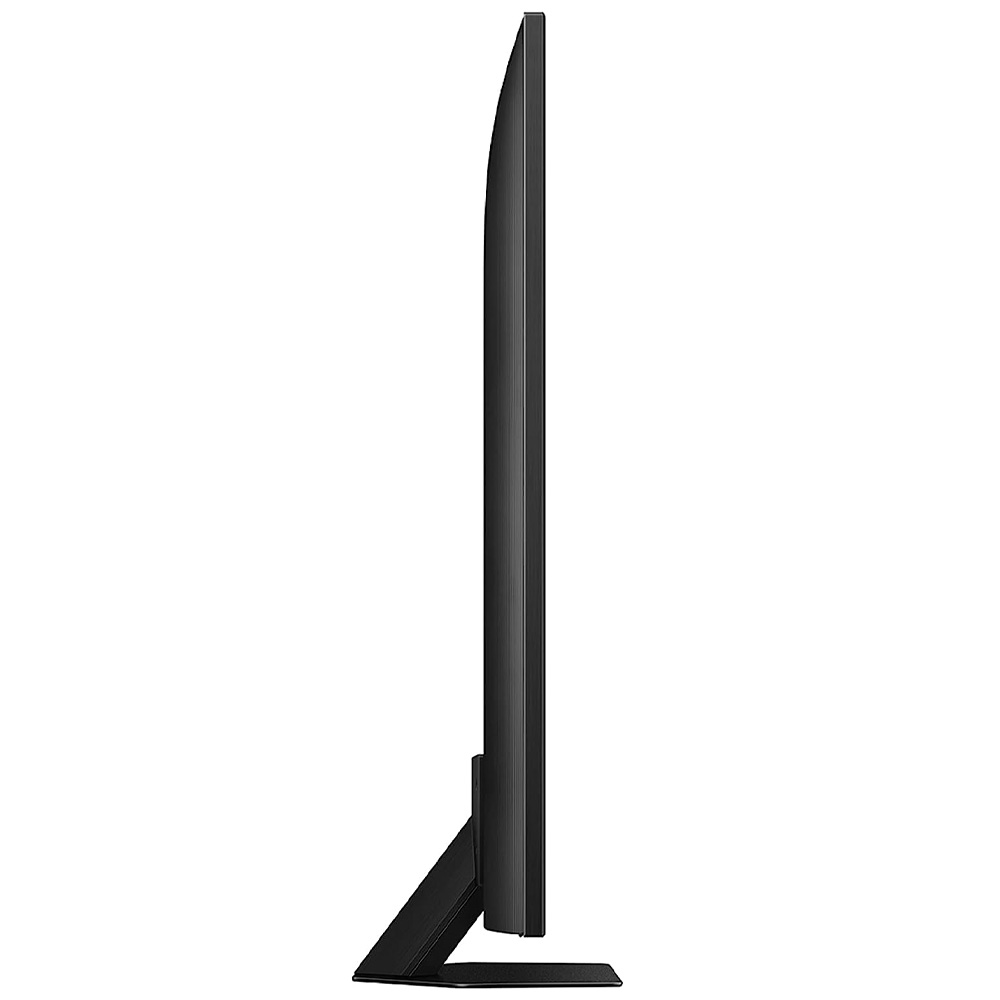
Back Side
Looking the back of the TV feels similar to the Q80B but is definitely different. The brushed texture has changed to a more vertical lines design. All ports are grouped together in an inset that is placed at the left side and all look sideways. This way you can reach them easier if you have it on a wall.
On the lower part of the panel we get special grooves in order to place your cables and drive them through the central stand. The power connector is placed on the right side, as usual, away from the rest of the connectors.
The VESA wall mount holes is the only other element visible at the back.
Stand
The stand also comes with a different look this year. It is still the same single central leg type of thing but it now comes in a hexagon design. With such a stand there is always some wobbling, especially with bigger sizes. But it is not so much as some other TVs we had tested.
At least you don’t need to have a fairly large surface to place it on. With this stand the clearance between the screen and the surface was more than 3″. This means that most soundbars should fit under it without a problem. Just make sure to measure beforehand just to be safe.

Remote
The remote included in the Q80C is exactly the same one as in all 2023 releases. So essentially it’s the same we used in our S95C and QN90C reviews. It is very similar to the 2022 remote but there are some minor design changes. The new remote lost one button at the top and it has a slightly different design with more round corners in all sides.
It is still small and uses very few buttons as it relies on the TV’s UI for most of its functions. It comes with a rechargeable battery that can be charged either through a USB-C cable or from its solar equipped back side.
The new remote is every bit as functional and practical as it was last year. To be honest we are not very thrilled by the minor design change but this comes down to personal taste.
Overall the Q80C is not going to win any design awards. But surely its quality is up to the usual Samsung standards. This is what you should expect from a mid-tier TV in 2023.
Video Quality
Processor technology used
One area where the Q80C seems to have improved over last year is processing. The new model now uses the Neural Quantum Processor 4K which is Samsung’s best processor in all of their top tier 4K TVs. And a definite upgrade over the Quantum Processor 4K that was used last year. Basically this is the same chip that the top-tier S95C is using this year.
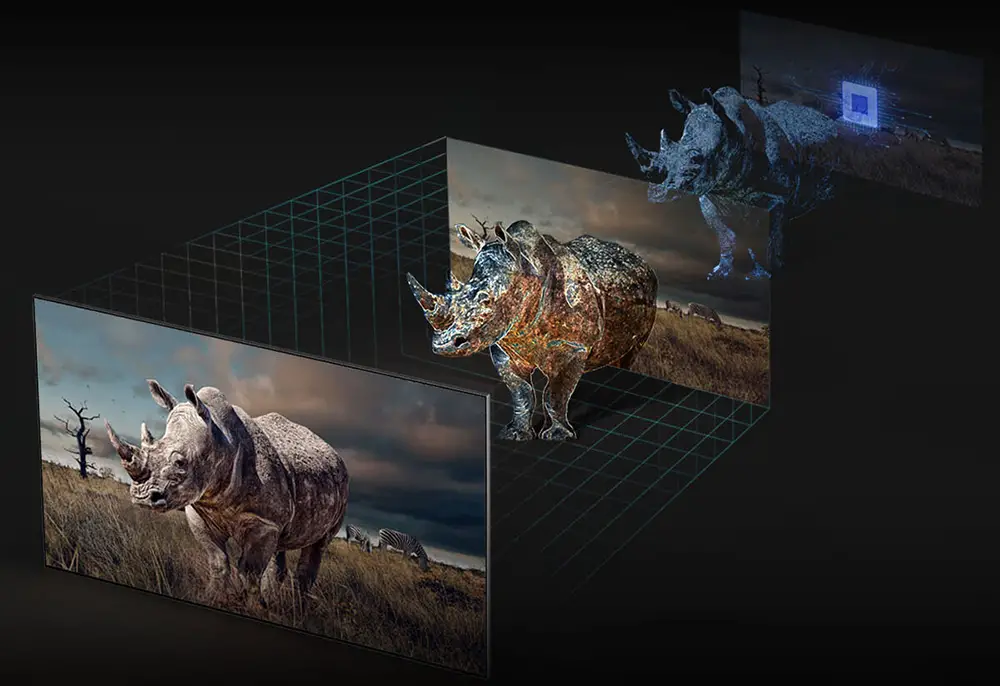
What we do know is that this processor uses up to 20 different neural network models. Each of them is trained in AI upscaling and deep learning technology. As a result the processor can optimize picture quality to 4K picture output regardless of the input quality.
Also its Real Depth Enhancer feature automatically separates objects in the content from the background. This creates a 3D like depth in order to make the image even more immersive.
Another feature that finds its way form previous years is Adaptive Picture. This can analyze the light conditions in your room and can calibrate the picture accordingly in order to provide you the best image quality for your specific situation.
Resolution and Up-scaling
We run a few videos in different resolutions ranging from ultra low quality ones, some 480p DVDs, some in 720p and obviously 1080p resolutions. In all our tests the Q80C upscaled the content without any artifacts or any other visible abnormalities. Upscaling was as good as it could be.
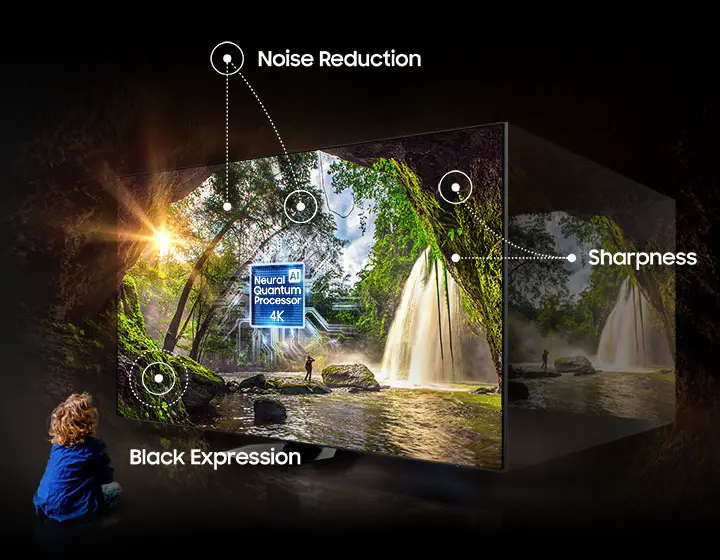
Audio Processing
Unfortunately while the processor was upgraded the audio system saw a downgrade. So instead of the OTS system found in the Q80B we get the OTS Lite variant. We will talk more about this in the dedicated audio section below.
Along with it we get various audio features like Adaptive Sound+ and Active Voice Amplifier (AVA).
Lighting technology used
A few years back FALD equipped TVs were considered the best choice when it came to backlights. But with the arrival of mini LED they became somewhat of a mid tier choice now. The last couple of years Samsung is using the FALD system in a single TV. As was the case last year with the Q80B, the same happened in 2023 with the Q80C being the only FALD equipped TV available.
FALD Explained
A FALD system in order to perform good depends on two factors, the number of dimming zones available and how fast each zone can change it’s light output. The more dimming zones used the better and more accurate light control the TV has but also the higher the price goes.
That’s why they usually scale the dimming zones number depending on the model. The effect on having low number of dimming zones can be seen when you see a very bright object on a completely dark background. If the TV has very few zones light will escape to the nearby pixels and create a visible halo around the object.
Also the light algorithms play a huge role as they control the response time of the various dimming zones. If the change is slower than it should be you will see what is called ghosting when a bright object moves very fast against a dark background.
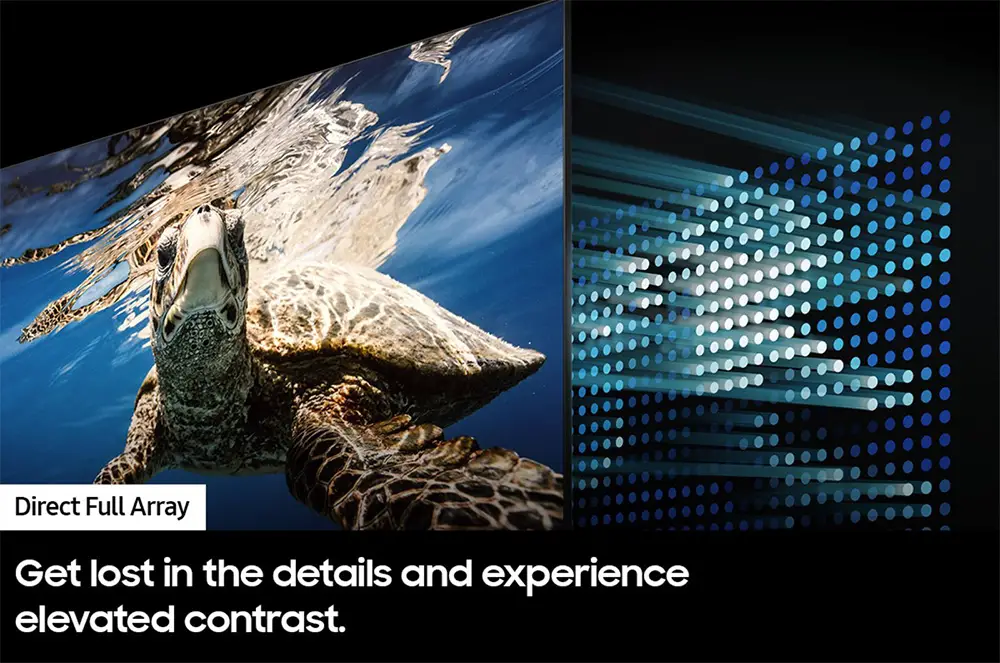
Number of Dimming Zones
It seems that the Q80C got an upgrade here. While the Q80B incorporated only 48 dimming zones the Q80C doubles that to 96 zones. We cannot say if this applies for all sizes but this is a definite increase over what we saw last year.
Obviously this is still a far cry from the hundreds of zones we were seeing in some top tier FALD units some years ago. But for a mid-tier TV this was to be expected.
Blooming & Zones Transitioning
To be honest the performance of the backlight in the Q80C disappointed us. With double the zones we were at least expecting to see some, even minor, improvement when it comes to blooming and zone transitioning. But in reality the Q80C behaved very similar to the Q80B.
We did notice some major blooming in specific scenes where bright highlights were rendered in a completely dark background. Also the local dimming feature was not particularly efficient and its dimming zones were too slow to turn off and on as it was becoming visible when a bright object would pass from one zone to the next.
So while the Q80C got double the zones, from what we saw, its performance remained mostly the same. A huge opportunity was lost here.

Brightness / Contrast
Next we will be looking at the brightness of the unit. In terms of settings we used the usual as we do in most Samsung models. We used the Movie mode and Warm 2 color tone along with Local Dimming set to High.
SDR and HDR Measurements
First test here is the SDR brightness over a 10% window and the number we got was 807 nits which is really good. In reality this is much more than any SDR content will ever need and this kind of brightness can overcome reflections and glare in a bright room.
We then switched to HDR content and in our HDR brightness over a 10% window test we measured 810 nits.
Automatic Brightness Limiter (ABL)
As with most TVs nowadays the Q80C comes with an Automatic Brightness Limiter (ABL). This system lowers the overall brightness of the screen when large parts of it become very bright for a long period of time. This may not be very obvious when watching a movie for example. But it can be noticed more with bright static images, or if you use the TV as a computer monitor.
The ABL on the Q80C is really subtle and most of the times you will never notice it. The changes in brightness are minimal and will not impact the overall image even during long periods of displaying the same static screen.

Last Year Comparison
Surprisingly the Q80C performed slightly worse than the Q80B. The difference is not big. But one would expect that with double the dimming zones light output would be higher.
Well, this is not the case here and surely the Q80C feels like a downgrade, even if it is a small one.
EOTF Tracking
Brightness levels were a bit above the EOTF reference values during the entire range. This results in slightly over-brightened images but thankfully it was not so much to be bothering.
Reaching its limit the TV has a sharp roll-off which results in some clipping and loss of detail.
Contrast Performance
In terms of contrast the Q80C comes with a ADS panel which basically is a panel very similar in structure to IPS ones. As a result contrast ratio suffers a lot with blacks looking very greyish. This is a problem particularly visible in a dark room where the grey-ish blacks are far more obvious. If you will be using this TV in a bright room then this problem will not be so evident.
Thankfully the Q80C seems to somewhat better than the Q80B and this probably happens because of the higher number of dimming zones utilized. But even so the performance of the Q80C is disappointing.
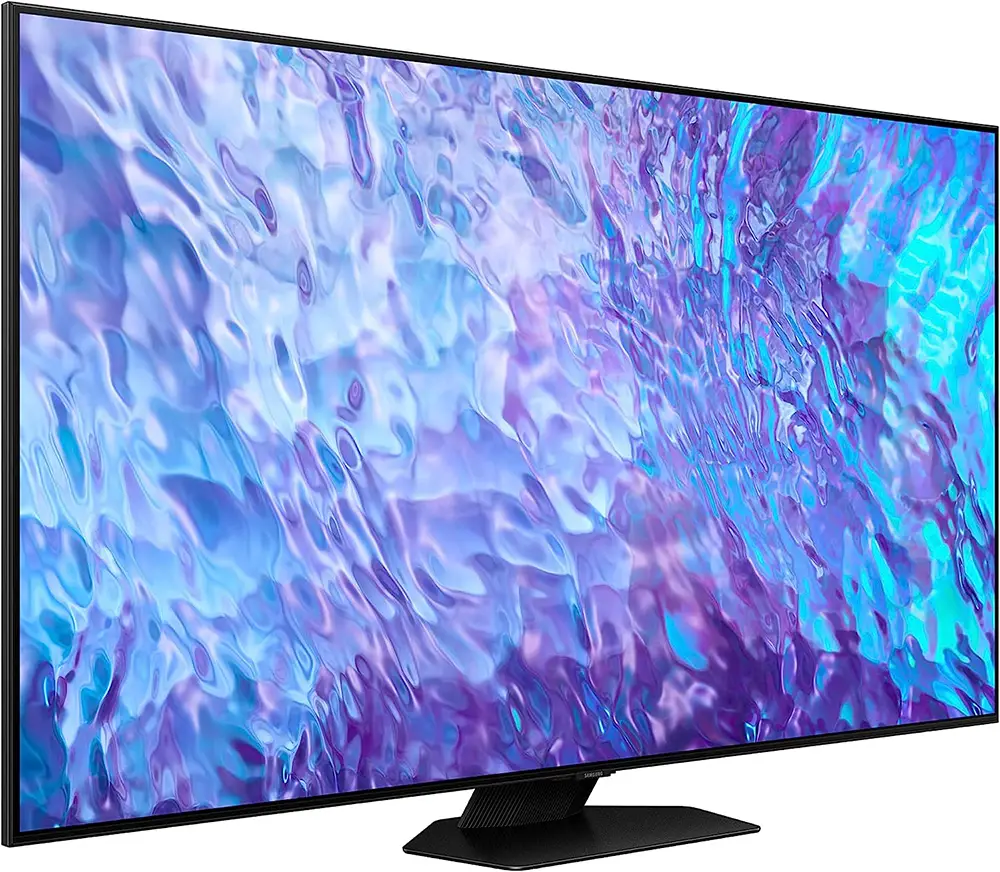
Viewing angles
The Q80C is using an ADS panel which is some type of IPS panel and this in general means good things in terms of viewing angles. Samsung mentions that the Q80C is using Wide Viewing Angle technology as the one found in some previous QLED models, which by the way is not the same as Ultra Viewing Angle that we see in some top premium units.
From what we saw we would say that a maximum of 40 degrees angle was acceptable with little degradation in overall image quality. Anything more and the image looses a lot in terms of brightness, colors and black levels. So if you are considering to use this as a family TV you shouldn’t have any problem with various viewing positions.
Not many differences with the Q80B. Since both TVs use the same kind of panel, viewing angles were bound to be similar.
HDR support
HDR support is another area where things haven’t changed much. As it seems that most brands stick to their guns without any changing in sight. As such we get the most basic HDR10 that is required for 4K UHD playback. There is also HLG that is used mainly for broadcasting. And lastly the newer HDR10+ which is the most advanced HDR protocol. This uses dynamic metadata in order to provide the best image quality on a frame by frame basis, similar to what Dolby Vision is doing.
In the Q80C we also find HDR10+ Adaptive and HDR10+ Gaming. HDR10+ Adaptive uses its AI engine to analyze the viewing environment. This includes the lighting, brightness and even reflections using the sensors equipped on the TV.
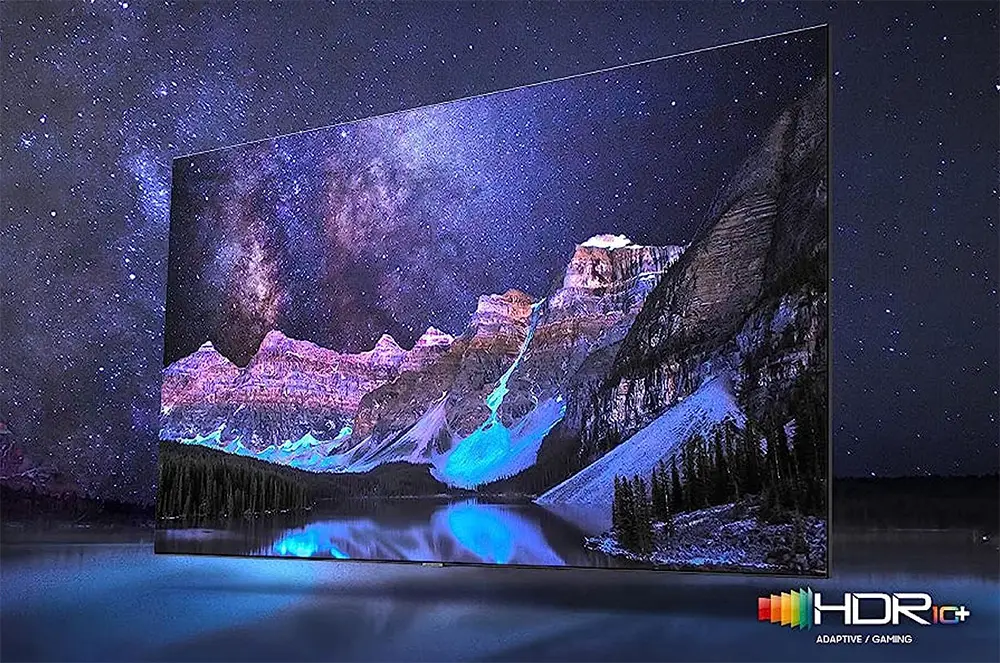
The results are then incorporated into the dynamic metadata. After going through four further steps, the brightness and contrast of a scene are optimized. This way you can view HDR10+ movies and television programs in various environments at home.
Keep in mind that like many new Samsung TVs the Q80C comes with an HDR Tone Mapping setting. You can set this to either Static or Active with Static being more accurate. Active will increase highlight intensity but makes the image less natural.
Unfortunately, Samsung still refuses to allow Dolby Vision in their TVs and stay firm behind their own HDR10+. A big disappointment, and we have no hopes this to change any time soon.
Color coverage
Being a QLED, the Q80C is using a special Quantum Dot layer in order to display 100% of the DCI-P3 color space. As always you should never take these promotional numbers literally, so let’s see how the Q80C really performs here.
From our measurements the TV can reach about 92% coverage of the DCI-P3 color space which is really good. On the wider REC.2020 color space we got a coverage of 69% which again is very good for the category this TV belongs in.
From these numbers it seems that the Q80C was able to perform very close to last year.

DeltaE Errors
Before calibration the TV had mediocre color accuracy. White balance, color temperature and gamma were way off their target values while most colors had values above the DeltaE limit of three.
After calibration we were able to correct many of the above errors. Color temperature was close to its target point, white balance was much better while we were able to bring gamma to more accurate levels. Also most colors were far more accurate with all of them below the DeltaE limit of three.
Keep in mind that even after calibration there were still minor inconsistences. But the TV performed far better than with out-of-the-box settings. Which makes the Q80C not an ideal TV for the casual user.
Color Gradients
Surprisingly color gradients were very good with some very minor banding across most colors. But this was very subtle and with real world content you are not going to notice it much.
There is also a Noise Reduction function in case you do see it. But if you enable it some detail is lost and in general we didn’t like this feature much.

Panel Uniformity
Panel uniformity was not very good in the Q80C. Gray uniformity revealed very notable differences between the corners and the center of the screen while with blacks the screen would show great inconsistences across the entire panel.
In general the TV showed all the same problems we saw in the Q80B. So no differences here.
Motion performance
We move on to our motion performance tests. It seems that the Q80C uses exactly the same configuration as previous years as it comes with a 100/120Hz panel along with a backlight dimming frequency of 960Hz. This is exactly the configuration we saw in both the Q80A and Q80B. Keep in mind that the 50″ size can only do 60Hz.
Having such a high frequency ensures that flickering is completely invisible but this also depends on the picture mode you will be using as in some of the them the frequency drops to 100/120 Hz.
Motion Interpolation
Motion interpolation could not be missing and is named Motion Xcelerator Turbo+. The Q80C was capable of removing both motion blur and stutter from content but as usual artifacts would become visible in some cases. In scenes where the camera would make fast movements the TV could not keep up. This resulted in some visible artifacts, and depending the content these would increase as the camera movements would become faster.

Motion Interpolation is enabled in the same way as with all other Samsung models. You will find it in the Picture Clarity settings, in the menu, and by adjusting the two sliders for blur or judder.
Keep in mind that very high values in the sliders and the “Soap Opera Effect” will appear. So if you want to improve motion keep minimal values in these two sliders. A value of 1 or 2 can smooth motion enough without affecting the quality much.
Black Frame Insertion (BFI)
Black Frame Insertion (BFI) is also available as usual which can be enabled in the menu with the LED Clear Motion option. BFI is a technique that inserts a black frame in between two individual frames in order to smooth out motion.
Although the end result is very good, it has a couple of side effects. First due to the black frames, brightness takes a visible hit. Also, due to the lower frequency used, which is 60Hz, some flickering may become noticeable. Keep in mind that the Q80C cannot use BFI with 120Hz as before. So 60Hz is the best it can do.
Overall Motion Impressions
We didn’t notice any major changes to motion performance compared to last year. The Q80C seems to be the same with very minor differences between the two.
The TV behaved more or less how you should expect from a mid-tier model. It has its ups and downs but with motion interpolation and BFI you have the option to chose the best for your situation.

Input lag Measurements
Input lag testing coming next.
According to our measurements the TV displayed an average of 10.8ms input lag in both 1080p and 4K resolutions at 60Hz. Switching to 120Hz input lag fell to 5.8ms, in both 1080p and 4K resolutions.
We took both measurements after we obviously switched to Game mode. If you switch to another picture mode the input lag will go up to 85ms.
This is another area where the TV was neck and neck with its predecessor. Small differences do not indicate any change and the Q80C remains an excellent low cost gaming TV.
Other Gaming Features
We should also not forget to mention that the TV supports Auto Low Latency Mode (ALLM). And both the PS5 and Xbox consoles support this feature, so the TV will switch to Game mode automatically.
HGiG Mode is not missing either. This is HDR Gaming Interest Group’s technology that ensures you enjoy HDR games the way that their creators and developers intended.
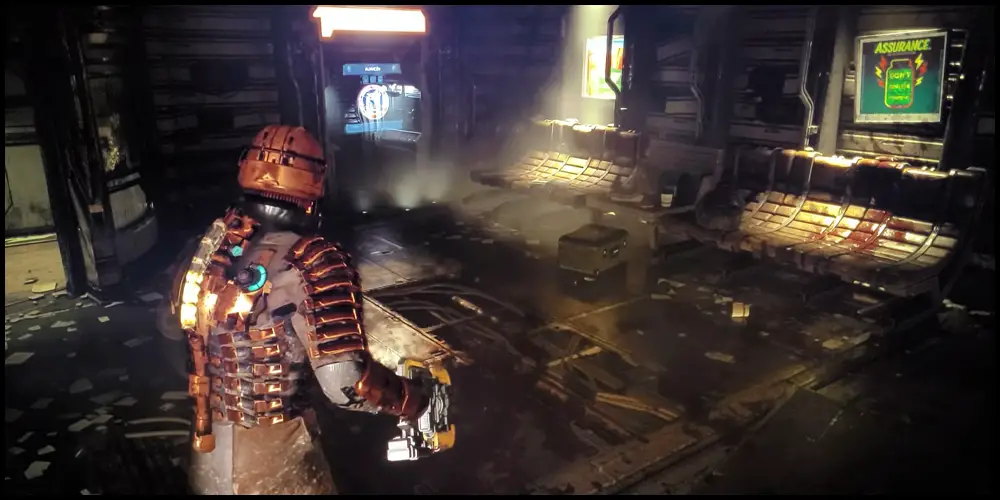
VRR Support
The Q80C makes sure to include all VRR support there is. As such we find HDMI Forum VRR, AMD FreeSync Premium Pro and NVIDIA G-Sync. And you can handle all of them in the new Game Bar 3.0.
One feature that we got in 2022 through a firmware update was the Samsung Game Hub. Well, this year it is available from the start in many of the new models, including the Q80C. With it you can use various online gaming services, including the Samsung-exclusive Xbox app. But as always the kind of content you will find in the Hub depends on the region you are.
Trying Out a Few Games
For testing the TV’s gaming capabilities we tried a couple of games. The first one was F1 2022 which has a 120Hz mode while the second one was Dead Space which goes only up to 60Hz.
Both games performed admirably with the Q80C. We didn’t notice any delay on our commands and the TV was very fast at rendering our actions on screen. Obviously we used the Game mode for that but even outside Game mode we were able to get a very respectable performance.
Obviously this is not ideal for fast paced online game but for slow offline ones the input lag outside Game mode was more than acceptable.

Overall Image Quality Impressions
Looking at the Q80C overall we cannot say that the 2023 is a clear improvement over the 2022 Q80B.
On the one hand contrast is better and the number of dimming zones has increased. But on the other hand the Q80B had much better out-of-the-box performance which surely will appeal more to casual users.
In all other areas both TVs behaved very close to each other. So we consider this a tie.
Audio Quality
As most brands, Samsung developed their own audio system to use in many of their top and middle tier models. It is called Object Tracking Sound and as of 2021 there are four variants of this system depending how capable it is. We have the OTS Pro, OTS+, OTS and OTS Lite.
The Q80C got the Object Tracking Sound Lite (OTS Lite) variant, which is actually a downgrade compared to last year’s OTS system used in the Q80B.
Audio System – Channels & Power Rating
The Object Tracking Sound Lite (OTS Lite) uses a 2.2 channels configuration with 40 watts of power output.
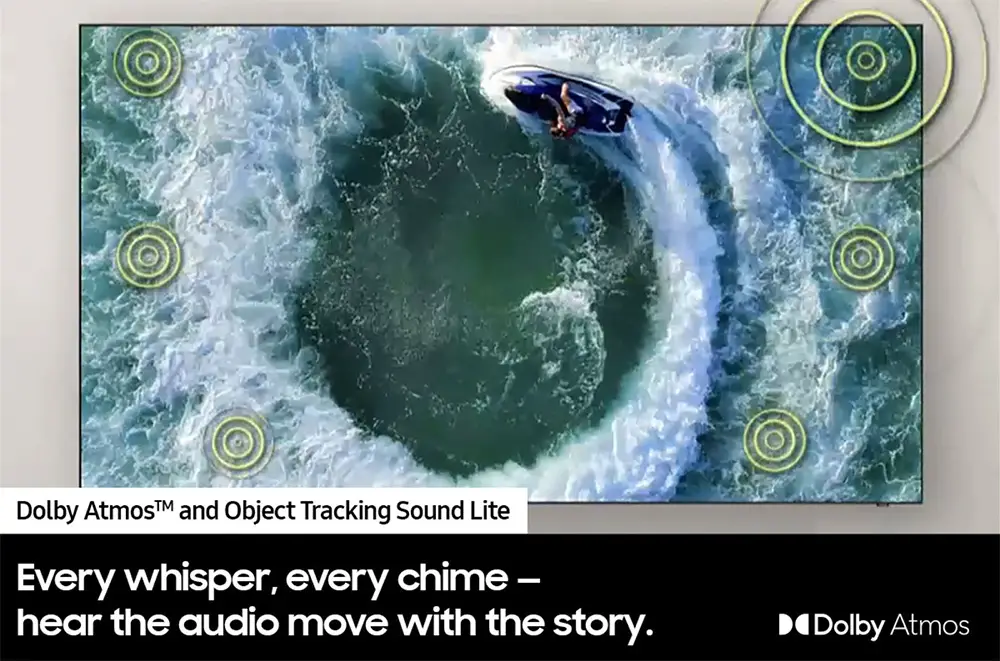
Audio Formats Support
The TV supports Dolby Atmos but don’t expect to get any kind of Atmos performance with such a toned down audio system. If you want to get the most out of it then you will certainly need a dedicated surround setup or at least a soundbar with surround speakers. Dolby Atmos can pass-through from eARC to some Dolby Atmos soundbar or dedicated sound system in this case.
Once again there is no DTS support. As such the TV cannot decode or pass-through DTS audio signals to another device. Samsung made that decision some years ago but with LG bringing it back in 2023 there is hope that Samsung will follow the same path in the coming years.
As it is right now both LG and Sony support DTS so Samsung remains the only one that doesn’t.
Audio Features
Samsung is adding a lot of audio features in their models, so let’s take a look at some of them.
First we find Adaptive Sound+ with which the TV analyzes the content and for each scene can identify and render the best sound type. This whole process starts by separating and classifying audio input signals. After it pulls out its key characteristics, it renders them to best suit the scene.
We also get Active Voice Amplifier (AVA). By using AVA the TV can detect environmental noise and enhance the voice output of the content you watch for a more pleasant viewing experience.
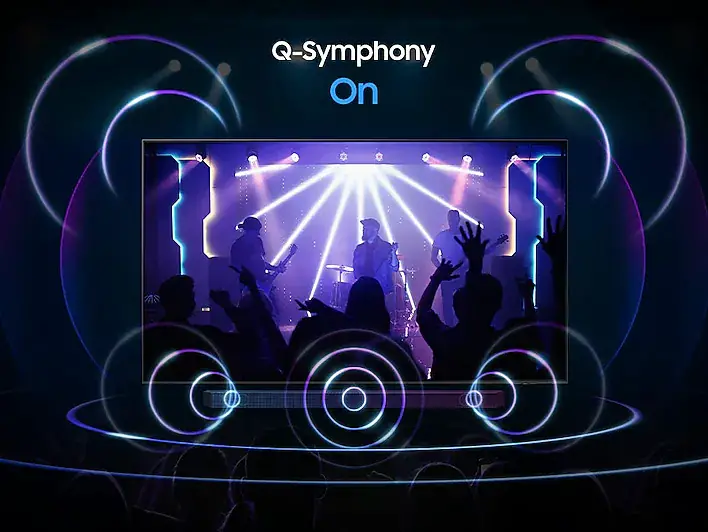
And obviously with a Samsung TV we could not miss Q-Symphony. This is a feature that you can use to combine the TVs audio system with an appropriate soundbar that supports it.
This year Samsung released Q-Symphony 3.0 and with it the audio can sync and output from both devices for an even more immersive audio experience. Samsung released a whole lineup of soundbars that support this feature in case you are thinking of getting one.
Overall Audio Performance Impressions
The Q80C may have seen a downgrade in its audio compared to last year but to be honest the difference is minor. For casual use all these systems will suffice. But if you want a real surround experience you will have to rely on a separate system or soundbar.
Ports and Connectivity
Samsung is using the exact same layout in many of their TVs for some years now. And the Q80C is no different.
Starting from the top right we find two USB ports, a single digital optical output, four HDMI ports, an Ethernet port for wired connection to your local network, an Ex-Link port and the usual antenna/cable connector.
HDMI Specifications
From 2022 onwards Samsung updated the HDMI ports in order for all of them to support the full 48Gbps bandwidth. And this continues into 2023 with the Q80C using four, fully capable HDMI 2.1 ports.
These support all new and old features including 4K@120, ARC, eARC, ALLM, VRR, G-Sync, FreeSync Premium Pro, HFR and HDMI-CEC.
The above do not apply to the 50″ size as this does not support 120Hz at all. Therefore its ports are the older HDMI 2.0 version.
Connectivity Observations
And while we could not be happier with the four HDMI 2.1 ports, the inclusion of a 100Mbps Ethernet port is inexcusable in 2023, even if we are talking about a mid-tier release as the Q80C is. We cannot understand why TV manufacturers still insist on not including Gigabit adapters.
Streaming requirements and internet connections have greatly advanced the last few years. This made the 100Mbps limit obsolete a while back. And while most TVs update their WiFi capabilities (some models support WiFi6 this year) the Ethernet adapters are still the same.
Wireless Capabilities
When it comes to its wireless capabilities the Samsung Q80C supports WiFi5 (802.11ac) along with Bluetooth 5.2 which is the same across all Samsung TVs in 2023.
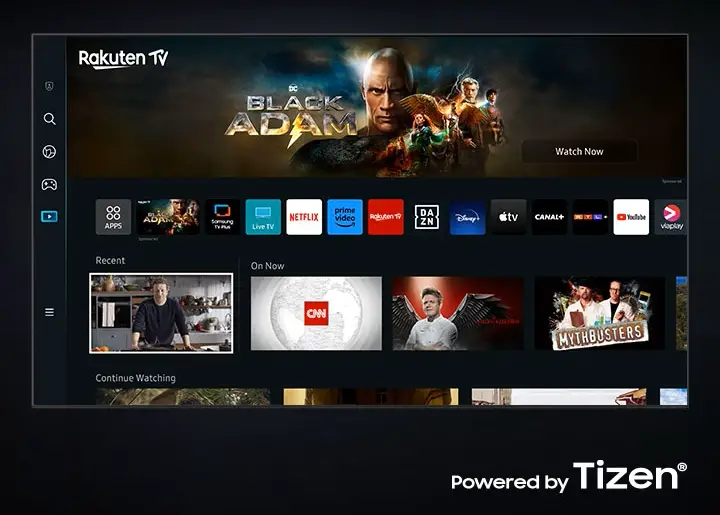
OS, Apps and Features
Samsung updated their OS to the latest 2023 version but this is only a minor upgrade compared to the 2022 version. Almost everything is still the same and this year there are small improvements and additions.
Tizen 2023
Being a Samsung TV means that for its OS we find the usual Tizen platform in its 2023 edition. The new Tizen occupies the whole screen instead of being a tile based row at the bottom of the screen, exactly as Google TV and webOS are lately.
It seems that smart TV platforms opt for a more personalized experience and as such the new OS tries to provide you with options that are tailored for your viewing habits. As such you will see personalized ads, recommendations for streaming services and broadcasting channels and even shopping suggestions.
If you have used Tizen before 2022, the new version may feel a bit chaotic at first. This was the same with Google TV and webOS when they changed into a full screen UI and certainly you will need to spend some time with it to get your bearings. But once you get the hung of it, it is easier to navigate than it may seem.
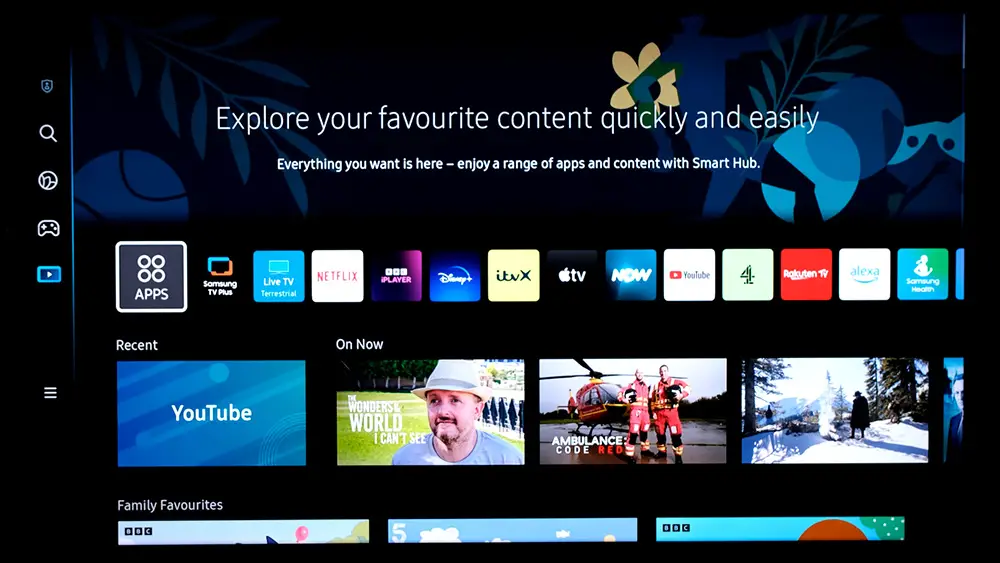
Samsung Smart TV Hub
The new Samsung Smart TV Hub includes different sections and it allows you to navigate easily through all of them. At the left of the screen there is a single column with a few central selections while the rest of the screen use rows with streaming services, apps and other functions and features available.
The new Tizen is not all that different really. Obviously the layout is tailored to Samsung’s needs but in essence it offers the same thing. Navigation was smooth enough and jumping from one app to the other was relatively fast and with no obvious lags or delays.
Game Bar 3.0
Let’s go over some of the features we find this year. These are all the same features we saw in our S95C review, so no real changes here. And the first we will talk about is the Game Bar.
In 2023 this feature is now in its 3.0 version. This is an on-screen menu that lets you make real-time adjustments to screen ratio, input lag check, FPS, HDR, wireless headset settings and more. This can be a really handy feature to gamers as you don’t have to mess with menus every time you want to check on a specific setting. With this quick feature you have everything in front of you with the click of a button.
The new Game Bar 3.0 has a couple 2023 features that were not available before. This is MiniMap sharing and Virtual Aim Point for gaming. And, as we mentioned above, Samsung TVs remain the only ones that include Xbox’s Game Pass.
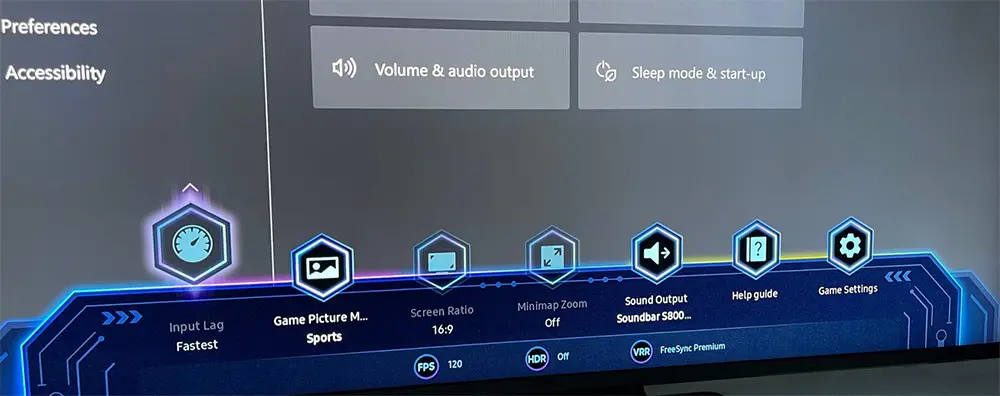
Streaming Capabilities
When it comes to content the Tizen platform is famous for it’s enormous support from developers. The Q80C offers practically all known services and platforms you can think of. Netflix, Apple TV, Disney Plus, Youtube, Amazon, Hulu, Rakuten, Demand 5 and BBC iPlayer are just a few of the big names available.
There is also Samsung TV plus which offers hundreds of subscription-free channels to choose from. Many of these services can playback in both 4K with HDR like Netflix and Amazon but this really depends on each app and not on the TV itself.
SmartThings Integration
With a Samsung TV SmartThings integration is a must. With it you can make your TV the central hub of all your smart houses devices. These can be lights, electronic locks, alarms, vacuum robots, thermostats and everything that supports the SmartThings platform.
For 2023 Samsung added Matter and Thread integration meaning you can control such devices from a single app instead of multiple ones and there is no need for an additional dongle as it is built-in the TV itself.
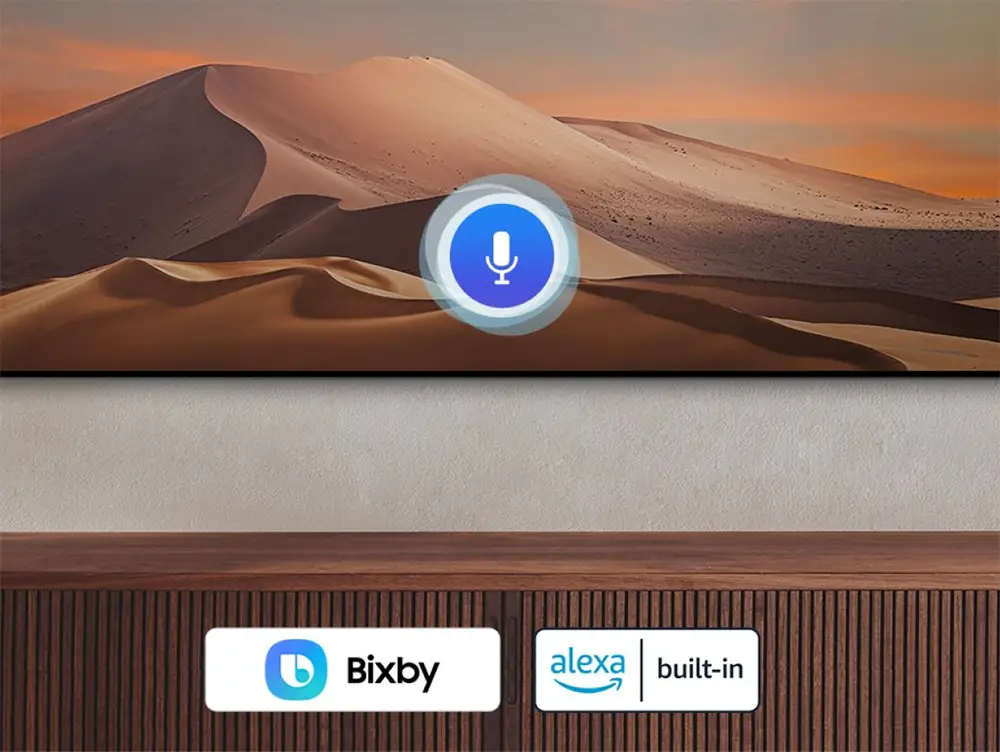
Voice Control
Voice control is another standard feature nowadays. It seems that Samsung is really trying to market their own Bixby service. But even if you are not very fond of that there is Amazon’s Alexa or Google Assistant to choose from. Only keep in mind that for Google Assistant you will need an external device for it to work.
On the other hand, if you are an Apple guy then don’t get disappointed as there is also Airplay 2 support. And you can even use Siri through it for your voice commands. Unfortunately while Airplay is available HomeKit is not, something that hasn’t really changed lately for Samsung.
Multi-View & Tap-View
Another feature that was introduced some time ago and seems to be a standard now is Multi-View. Although at it’s core this is not something entirely new Samsung took it a step further. Multi-View is basically a more advanced screen mirroring program. But with it instead of just simply projecting the screen from your mobile device on the TV you can choose to have two screens showing both TV content and what your mobile device shows.
In addition to Multi-View there is also Tap View. With it you can mirror your phone on your TV with just a tap to continue enjoying movies, music, and apps on the bigger screen within seconds. Nothing major, but anything that can save even a few seconds of your time can be valuable.
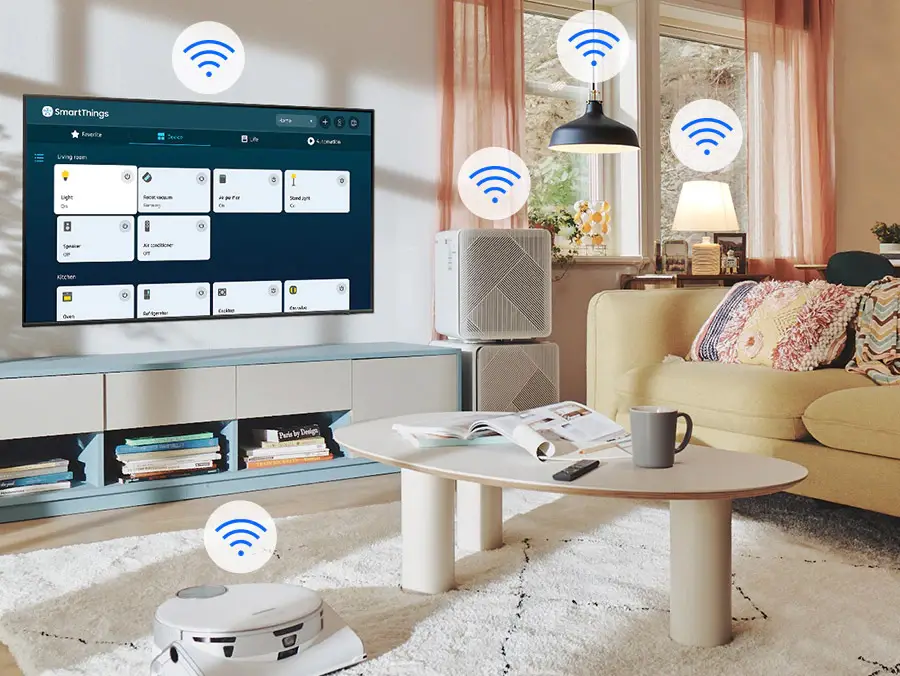
Ambient Mode+
Another returning feature is Ambient Mode+. This is a slightly more enhanced version of the Ambient Mode we get in many Samsung models for the last few years. With the plus version except from the ability to display various images on the TV, when not in use, it can also project various information including weather updates, news headlines, photos and music.
Samsung Health
Samsung Health is another standard feature by now. The last couple of years, with the coronavirus pandemic, many people were staying indoors so Samsung thought that exercise at home would be on the rise. So many of their TVs came with Samsung’s program in order to stay in shape. It seems that Samsung liked it so they decided to keep it.
Compared to other TVs
As we mentioned above compared to the 2022 Q80B the new Q80C is not all that different. From one side the Q80C comes with a newer processor, has more dimming zones and better contrast but the Q80B was slightly brighter, has better out-of-the-box performance and a slightly better audio system. So in essence we consider both of them equals.
From Sony we could compare the Q80C with the X85K and X90K although both are not exactly at the same price as the Samsung. Obviously being 2022 models we cannot be sure how they are priced today but according to their initial pricing, this reflects their actual performance. The X85K performed worse that the Q80C while the X90K is better in some areas.
Unfortunately we have yet to test any of the competing brands that are in the same category as the Q80C this year. When we test what LG and Sony have in the same price we will make sure to mention it in the corresponding articles.
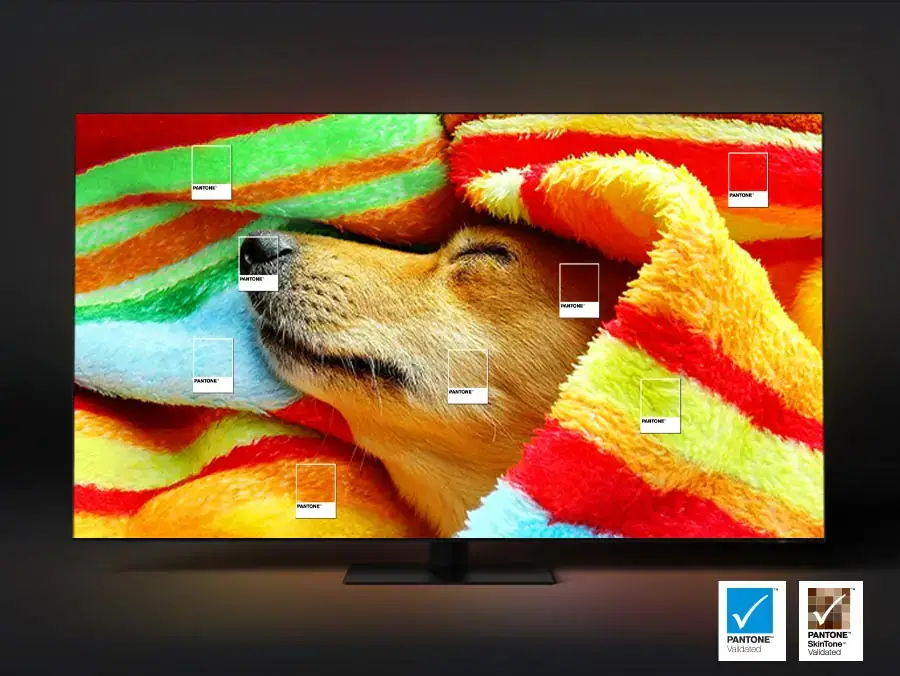
Final Thoughts
If you were expecting the 2023 Q80C to be vastly different than its predecessor you will surely be disappointed. The new release, although not entirely the same as the Q80B, has many similarities to it.
The Q80C’s strong points are its nice upscaling, good color coverage and gradients, satisfactory viewing angles, good brightness, solid motion performance and excellent gaming and smart features. Coming with four HDMI 2.1 ports, 120Hz capabilities and low input lag will surely satisfy most gamers that look for an affordable all around TV.
On the other hand the TV’s out of the box performance truly disappoints. If you hate calibrating your TV and want it to look good with default settings then surely the Q80B will not satisfy you. The higher number of dimming zones didn’t have a drastic effect on lower the blooming while blacks look more grey-ish. Lastly its audio is nothing exceptional to talk about while the lack of Dolby Vision and DTS will haunt Samsung for another year.
Closing our review we can say that the Samsung Q80C is really good if you are looking for an all around TV that can do exceptionally good with gaming but will also satisfy your movie needs. It surely has its fare share of problems but for its affordable price this model will surely catch a big chunk of the mid-tier market.
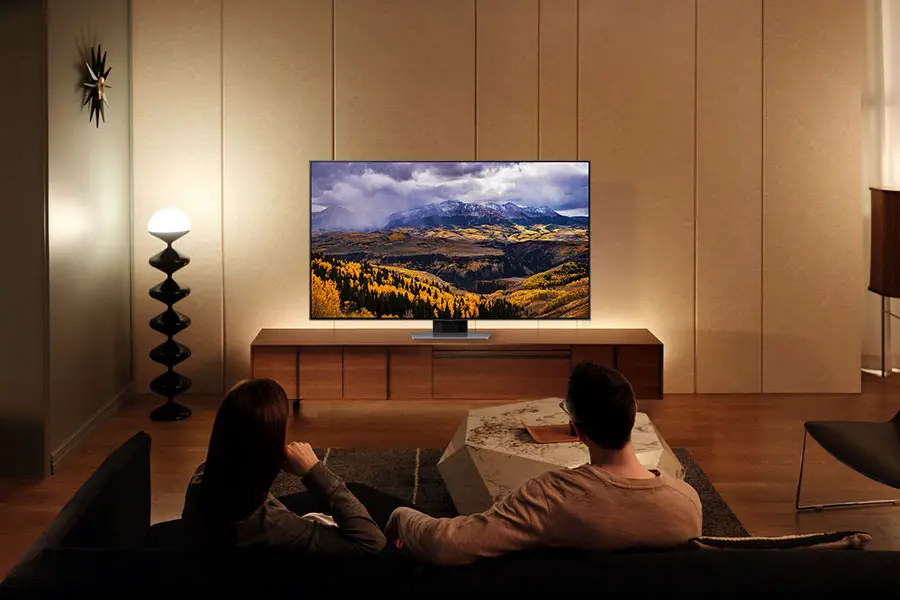
For more reviews you can check our dedicated 4K LED LCD TV reviews list or even look at our Product Reviews Table where you can find the brand and specific product you are looking for.
Cheapest Places to Buy :
*We are a reader-supported website. When you buy through links on our site, we may earn a small affiliate commission at no extra cost to you. Home Media Entertainment does not accept money for reviews.*
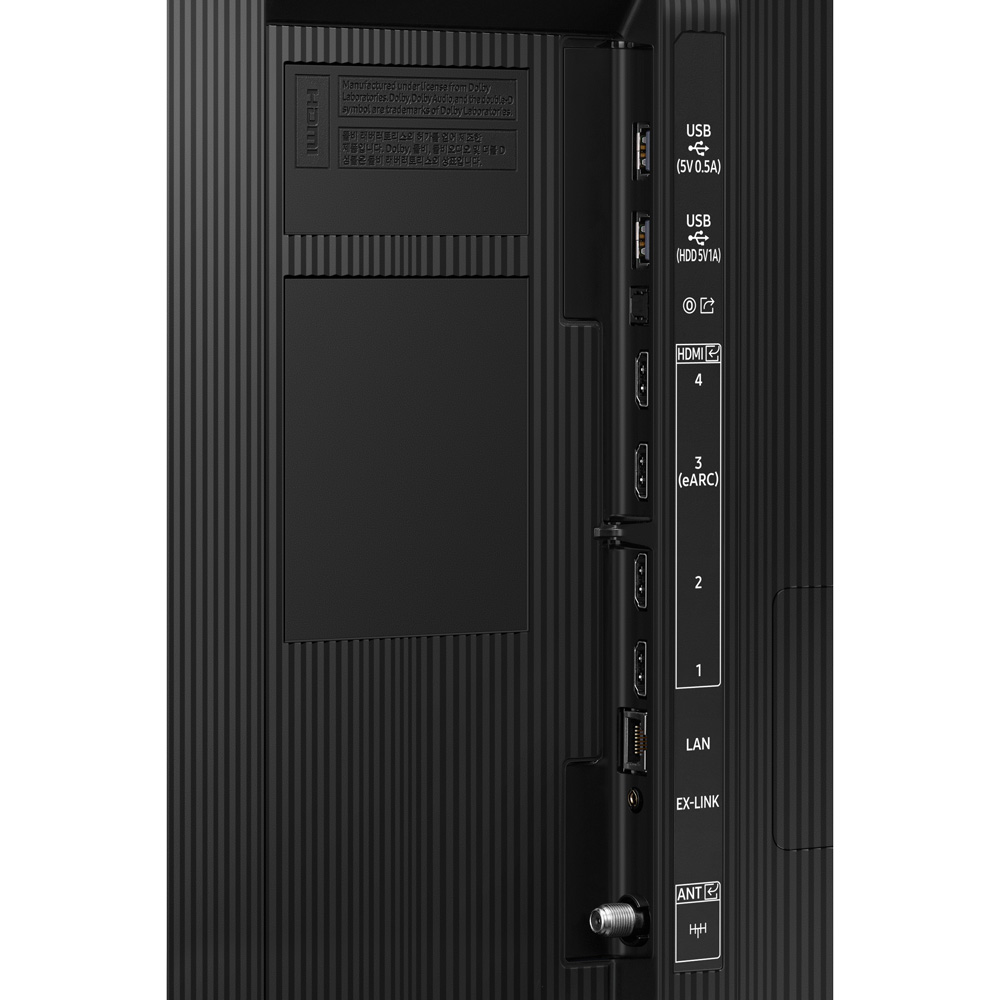
I am looking for a cheap gaming TV and I am considering all options right now. The Q80C seems to be the one from Samsung back what about LG and Sony? I will definitely wait for their cheaper gaming TVs first before making up my mind. Any news on them and when you will review them?
Hello Will. We are going to review more of LG and Sony but Samsung was one of the first TVs we got our hands on. Soon more reviews will be published from the other manufacturers.
More of the same from Samsung. I do get that they have to empty their inventory of those FALD systems but I think that with mini LED FALD is already obsolete. Obviously QD-OLED is all the rage the last couple of years and the only reason someone would go for the Q80C is because they want a cheap gaming Samsung TV.
You will be amazing how important the power of branding is. Many people will go for Samsung just because of the name, even if their TVs are pricier than the competition. Take Hisense for example. They offer some of the best value for money TVs right now with far better performance and lower pricing than Samsung. But still many people are hesitant to go for Hisense because they are afraid of their quality. And prefer to pay more and get worse quality because they believe Samsung offers them some sense of security and quality that Hisense don’t.
Samsung QE55Q80C vs Hisense 55E7KQTUK Pro what do you think has the better image quality?
Hello James. Unfortunately I haven’t tested this Hisense so I cannot have a personal opinion on it.